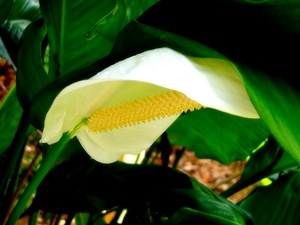If you love houseplants but your home doesn’t offer adequate sunshine, consider growing peace lilies. These attractive flowering plants don’t require a great deal of light, and they thrive in average home temperatures. Peace lilies are undemanding, trouble-free, and they are a lovely addition to any home or office. Growing and caring for a peace lily plant is really very easy.
Most peace lily varieties reach a maximum growing height and width of 4 feet, and they make wonderful floor plants. Tall sturdy stems exhibit pale green blooms that turn snow-white as they develop and mature. Their satiny flowers are similar in appearance to the calla lily, and they gently curve around creamy yellow centers. The flowers are perched on tall sturdy stems that rise above glossy deep green leaves shaped like pointed sails. The shape of the leaves is where the alternate name, sail plant, originates.
Ideal Growing Conditions
Peace lilies will flourish in dimly lit areas and they can be successfully grown under artificial lighting, but they prefer a little natural sunlight. Direct sunlight can damage the foliage, but indirect or filtered sunshine is satisfactory. If you notice yellow leaves, carefully remove them, and relocate the plant to a shadier location.
Average daytime household temperatures between 68ºF and 85ºF, and nighttime temperatures approximately 10 degrees cooler are ideal for growing peace lilies. Move them in the evening to a cooler location such as an unheated room, a lower level, or turn down the heat in your home.
Peace lilies thrive in humidity, so a light misting once a day will clean the leaves as well as provide a little extra humidity to the plant. Additional humidity can be achieved by setting the plant on a saucer of water and stones. Add stones to a plant saucer, and fill it with water just below the top of the stones. As the plant rests upon the stones, the water will evaporate and add humidity to the air surrounding the plant.
Watering & Feeding
Provide your peace lily with enough tepid water to keep the soil evenly moist but not saturated. Peace lilies are sensitive to chlorine, so if your tap water is chlorinated, allow it to set in an open container overnight so it will dissipate. You can also water your peace lily with rainwater or distilled water.
How often the plant will require water greatly depends on room temperature, humidity, and lighting. Use your own judgment when determining how often to water the plant. The soil should never become completely dry, but the saucer beneath the plant should never hold water.
Feed your peace lily once a month during the growing season with water-soluble houseplant fertilizer. Too much fertilizer will burn this sensitive plant by damaging the edges of the leaves and delicate roots. Prevent damage by diluting the solution to ¼ of the recommended dosage.
Repotting & Propagation
Peace lilies are fast growing houseplants, and in just one year, they can double in size. More than likely, your plant will require repotting every other year, and you might want to separate one plant into several.
When it’s time for repotting, choose sterile potting mix containing peat moss, silica sand, and bark, and select a well draining pot. Besides providing more growing room for the plant, a pot containing new soil will provide essential nutrients that may be lacking in older soil.
In the spring, you can propagate one plant into two or more plants. Gently remove the plant from the pot and carefully separate the root ball into two or more individual plants. Repot them at the same depth as before, and provide the plant with a tepid drink of water when the potting soil begins to dry.
Pests aren’t usually a problem when growing peace lilies, but sometimes red spider mites, mealy bugs, and greenflies take up residence. If you notice insects under the leaves or in the soil, apply a commercial insecticide recommended for peace lilies. Alternately you can wipe the leaves with rubbing alcohol, or wash the leaves with insecticidal soap according to product label instructions.




